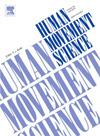Can children at risk for developmental coordination disorder step-clap to the beat? Evidence from an online motion tracking study
IF 1.9
3区 心理学
Q4 NEUROSCIENCES
引用次数: 0
Abstract
Developmental coordination disorder (DCD) is a neurodevelopmental disorder involving deficits in motor coordination. Recent evidence has shown children at risk for DCD have associated auditory timing perception and auditory-motor synchronization deficits, but it remains unclear how these deficits would appear in full-body coordination tasks, particularly as DCD is often associated with gross motor impairments such as balance and gait. Current interventions for DCD focus on motor training alone, although preliminary findings suggest that motor interventions with rhythmic auditory cueing may confer additional benefit. To investigate auditory-motor synchronization during full-body coordination, we tested whether children aged 9–12 at risk for DCD could synchronize a step-clap dance step to various auditory stimuli using online data collection. Frequency analysis of the tracked head, hands, and feet showed that children at risk for DCD perform the dance step overall slower compared to typically developing children. Cross-correlations of the movements to an interpolated harmonic wave representing the auditory beats showed the group at risk for DCD were less coordinated to the auditory beat compared to typically developing children at the fast tempi, but that both groups performed similarly at slower tempi. Additionally, both groups were more coordinated and less variable at slower compared to faster tempi. These results indicating better performance in children at risk for DCD at slower auditory tempi are important for informing decisions on auditory stimuli during the design of auditory-motor interventions for DCD.
有发育性协调障碍风险的儿童能跟着节拍拍手吗?来自一项在线运动追踪研究的证据
发育协调障碍(DCD)是一种涉及运动协调缺陷的神经发育障碍。最近的证据表明,有DCD风险的儿童有听觉时间感知和听觉运动同步缺陷,但目前尚不清楚这些缺陷如何在全身协调任务中出现,特别是DCD通常与平衡和步态等大运动障碍有关。目前对DCD的干预只关注于运动训练,尽管初步研究结果表明,有节奏的听觉提示的运动干预可能会带来额外的好处。为了研究全身协调过程中的听觉-运动同步,我们使用在线数据收集测试了9-12岁有DCD风险的儿童是否可以同步各种听觉刺激的拍手舞步。对头部、手和脚的跟踪频率分析表明,与正常发育的儿童相比,有DCD风险的儿童跳舞的速度总体较慢。运动与代表听觉节拍的插入谐波的相互关联表明,与正常发育的儿童相比,有DCD风险的儿童在快节奏下对听觉节拍的协调程度较低,但两组在慢节奏下的表现相似。此外,与快节奏相比,两组人在慢节奏下更协调,变化更少。这些结果表明,在听觉节奏较慢的情况下,有DCD风险的儿童表现更好,这对于在设计DCD的听觉-运动干预措施时决定听觉刺激具有重要意义。
本文章由计算机程序翻译,如有差异,请以英文原文为准。
求助全文
约1分钟内获得全文
求助全文
来源期刊

Human Movement Science
医学-神经科学
CiteScore
3.80
自引率
4.80%
发文量
89
审稿时长
42 days
期刊介绍:
Human Movement Science provides a medium for publishing disciplinary and multidisciplinary studies on human movement. It brings together psychological, biomechanical and neurophysiological research on the control, organization and learning of human movement, including the perceptual support of movement. The overarching goal of the journal is to publish articles that help advance theoretical understanding of the control and organization of human movement, as well as changes therein as a function of development, learning and rehabilitation. The nature of the research reported may vary from fundamental theoretical or empirical studies to more applied studies in the fields of, for example, sport, dance and rehabilitation with the proviso that all studies have a distinct theoretical bearing. Also, reviews and meta-studies advancing the understanding of human movement are welcome.
These aims and scope imply that purely descriptive studies are not acceptable, while methodological articles are only acceptable if the methodology in question opens up new vistas in understanding the control and organization of human movement. The same holds for articles on exercise physiology, which in general are not supported, unless they speak to the control and organization of human movement. In general, it is required that the theoretical message of articles published in Human Movement Science is, to a certain extent, innovative and not dismissible as just "more of the same."
 求助内容:
求助内容: 应助结果提醒方式:
应助结果提醒方式:


